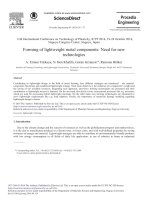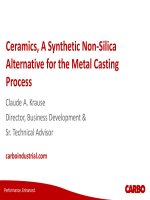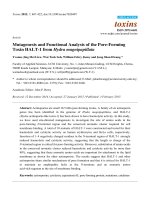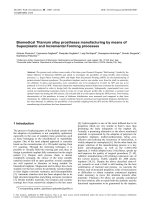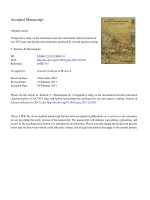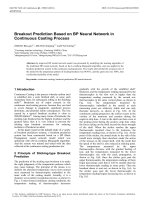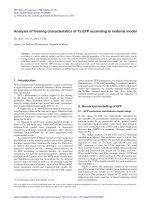BGE casting forming
Bạn đang xem bản rút gọn của tài liệu. Xem và tải ngay bản đầy đủ của tài liệu tại đây (1.94 MB, 56 trang )
IEEM 215: Manufacturing Processes
Traditional Manufacturing Processes
Casting
Forming
Sheet metal processing
Powder- and Ceramics Processing
Plastics processing
Cutting
Joining
Surface treatment
Casting
Refractory mold pour liquid metal solidify, remove finish
• VERSATILE: complex geometry, internal cavities, hollow sections
• VERSATILE: small (~10 grams) very large parts (~1000 Kg)
• ECONOMICAL: little wastage (extra metal is re-used)
• ISOTROPIC: cast parts have same properties along all directions
Different Casting Processes
Process
Advantages
Disadvantages
Examples
Sand
many metals, sizes, shapes, cheap
poor finish & tolerance
engine blocks,
cylinder heads
Shell mold
better accuracy, finish, higher
production rate
limited part size
connecting rods, gear
housings
Expendable
pattern
Wide range of metals, sizes,
shapes
patterns have low
strength
cylinder heads, brake
components
Plaster mold
complex shapes, good surface
finish
non-ferrous metals, low
production rate
prototypes of
mechanical parts
Ceramic mold
complex shapes, high accuracy,
good finish
small sizes
impellers, injection
mold tooling
Investment
complex shapes, excellent finish
small parts, expensive
jewellery
Permanent
mold
good finish, low porosity, high
production rate
Costly mold, simpler
shapes only
gears, gear housings
Die
Excellent dimensional accuracy,
high production rate
costly dies, small parts,
non-ferrous metals
gears, camera bodies,
car wheels
Centrifugal
Large cylindrical parts, good
quality
Expensive, few shapes
pipes, boilers,
flywheels
Sand Casting
Sand Casting
cope: top half
drag: bottom half
core: for internal cavities
pattern: positive
funnel sprue
runners gate
cavity
{risers, vents}
Sand Casting Considerations
(a) How do we make the pattern?
[cut, carve, machine]
(b) Why is the pattern not exactly identical to the part shape?
- pattern outer surfaces; (inner surfaces: core)
- shrinkage, post-processing
(c) parting line
- how to determine?
Sand Casting Considerations..
(d) taper
- do we need it ?
(e) core prints, chaplets
- hold the core in position
- chaplet is metal (why?)
chaplet
Mold
cavity
(f) cut-off, finishing
Shell mold casting
- metal, 2-piece pattern, 175°C-370°C
- coated with a lubricant (silicone)
- mixture of sand, thermoset resin/epoxy
- cure (baking)
- remove patterns, join half-shells mold
- pour metal
- solidify (cooling)
- break shell part
Expendable Mold Casting
- Styrofoam pattern
- dipped in refractory slurry dried
- sand (support)
- pour liquid metal
- foam evaporates, metal fills the shell
- cool, solidify
- break shell part
molten
metal
polystyrene
pattern
support
sand
pattern
polystyrene
burns;
gas escapes
Plaster-mold, Ceramic-mold casting
Plaster-mold slurry: plaster of paris (CaSO4), talc, silica flour
Ceramic-mold slurry: silica, powdered Zircon (ZrSiO4)
- The slurry forms a shell over the pattern
- Dried in a low temperature oven
- Remove pattern
- Backed by clay (strength), baked (burn-off volatiles)
- cast the metal
- break mold part
Plaster-mold:
good finish (Why ?)
plaster: low conductivity => low warpage, residual stress
low mp metal (Zn, Al, Cu, Mg)
Ceramic-mold:
good finish
high mp metals (steel, …) => impeller blades, turbines, …
Investment casting (lost wax casting)
(a) Wax pattern
(injection molding)
(d) dry ceramic
melt out the wax
fire ceramic (burn wax)
(e) Pour molten metal (gravity)
cool, solidify
[Hollow casting:
pouring excess metal before solidification
(b) Multiple patterns
assembled to wax sprue
(c) Shell built
immerse into ceramic slurry
immerse into fine sand
(few layers)
(f) Break ceramic shell
(vibration or water blasting)
(g) Cut off parts
(high-speed friction saw)
finishing (polish)
Vacuum casting
Similar to investment casting, except: fill mold by reverse gravity
Easier to make hollow casting: early pour out
Permanent mold casting
MOLD: made of metal (cast iron, steel, refractory alloys)
CORE: (hollow parts)
- metal: core can be extracted from the part
- sand-bonded: core must be destroyed to remove
Mold-surface: coated with refractory material
- Spray with lubricant (graphite, silica)
- improve flow, increase life
- good tolerance, good surface finish
- low mp metals (Cu, Bronze, Al, Mg)
Die casting
- a type of permanent mold casting
- common uses: components for
rice cookers, stoves, fans, washing-, drying machines,
fridges, motors, toys, hand-tools, car wheels, …
HOT CHAMBER: (low mp e.g. Zn, Pb; non-alloying)
(i) die is closed, gooseneck cylinder is filled with molten metal
(ii) plunger pushes molten metal through gooseneck into cavity
(iii) metal is held under pressure until it solidifies
(iv) die opens, cores retracted; plunger returns
(v) ejector pins push casting out of ejector die
COLD CHAMBER: (high mp e.g. Cu, Al)
(i) die closed, molten metal is ladled into cylinder
(ii) plunger pushes molten metal into die cavity
(iii) metal is held under high pressure until it solidifies
(iv) die opens, plunger pushes solidified slug from the cylinder
(v) cores retracted
(iv) ejector pins push casting off ejector die
Centrifugal casting
- permanent mold
- rotated about its axis at 300 ~ 3000 rpm
- molten metal is poured
- Surface finish: better along outer diameter than inner,
- Impurities, inclusions, closer to the inner diameter (why ?)
Casting Design: Typical casting defects
Casting Design: Defects and Associated Problems
- Surface defects: finish, stress concentration
- Interior holes, inclusions: stress concentrations
σ0
σmax
2a
σmax = σ0(1 + 2b/a)
2b
σ0
Casting Design: guidelines
(a) avoid sharp corners
(b) use fillets to blend section changes smoothly
(c1) avoid rapid changes in cross-section areas
Casting Design: guidelines
(c1) avoid rapid changes in cross-section areas
(c2) if unavoidable, design mold to ensure
- easy metal flow
- uniform, rapid cooling (use chills, fluid-cooled tubes)
Casting Design: guidelines
(d) avoid large, flat areas
- warpage due to residual stresses (why?)
Casting Design: guidelines
(e) provide drafts and tapers
- easy removal, avoid damage
- along what direction should we taper ?
Casting Design: guidelines
(f) account for shrinkage
- geometry
- shrinkage cavities
Casting Design: guidelines
(g) proper design of parting line
- “flattest” parting line is best
Traditional Manufacturing Processes
Casting
Forming
Sheet metal processing
Powder- and Ceramics Processing
Plastics processing
Cutting
Joining
Surface treatment

